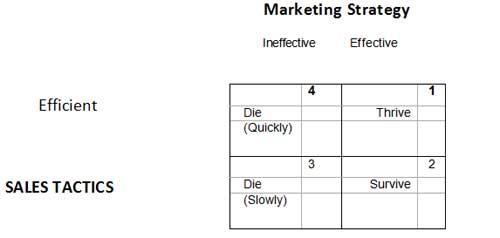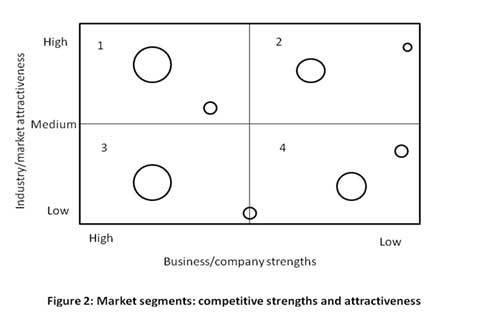





The separation of the sales and marketing functions organisationally has had a major malign effect on the reputation of both disciplines. This short piece addresses this issue.
May I please declare my own (non financial) interest in this topic. At Canada Dry over thirty years ago, I was Marketing and Sales Director. The Sales Director reported to me and we had as a result a perfect fusion of the two functions. I involved the Sales Director deeply in our strategic marketing planning and he and his senior people brought a different, pragmatic perspective to the more structured, diagnostic and process-driven thinking of the marketers. The result was a strategy for markets and customers that was fully accepted and, more importantly, implemented by the sales force.
Without such fusion, what tends to happen is that the product/market/segment/customer mix is determined by the sales force and the resulting revenue/profit mix has to be used as the basis for strategic planning - a classic case of the tail wagging the dog! The extreme example of the total separation of the two functions occurs in professional service firms. It is clear in such organisations that most marketing takes place during the process of delivering the professional service and during other informal client contacts. Hence, the term "marketing" encapsulates both marketing and service delivery. In many such firms, it is not surprising that marketing is often merely a promotional function. Some forward-looking firms, however, have appointed a senior "Marketing Partner" who oversees both sales and marketing, with excellent results.
As you rightly say, the literature is replete with criticism of the lack of pragmatism in many marketing strategies emanating from the marketing department. Typical is the following, from Neil Rackham.
"Value propositions have a bad reputation in selling because they are usually too generic and theoretical. Sales and Marketing should jointly customise value propositions."
Even worse, McKinsey report that 60-70% of UK companies use the terms within their companies, but only 5% have clearly articulated written value propositions.
In the second decade of the 21st century, expenditure or personal selling is still considerably larger than the combined expenditure on both advertising and sales promotion, in spite of a fashionable belief in the 1980s that precisely targeted marketing methods would make the need for personal selling all but disappear.
The reason that the reverse has happened is simply because no one has yet discovered a more effective way of communicating with customers, of exploring the needs of increasingly complex decision-making units, of alleviating any concerns they may have, and of communicating the full benefits of a company's offer. Additionally, research shows that, contrary to popular belief, companies welcome representatives as a valuable source of information about developments.
Vast sums of money have been spent during the past decade by many organisations, with the aim of improving the sales force's productivity. Great strides forward have been made in most areas of sales force manage¬ment. In particular, most sales people today recognise when to sell and when to negotiate. Territory allocation and planning is no longer the hit-and-miss affair that it used to be. Recruitment is now a much more scientific process, with most firms aware of the value of psychometric testing as part of the selection process. Sales managers tend to use more supportive team-building methods rather than the old, hierarchical, tyrannical ways. Remuneration packages are better related to the tasks that have to be performed. Evaluation procedures have improved dramatically with the advent of relational databases. In general, it can be concluded that today's sales forces are more motivated, more professional, and more productive than they were ten years ago.
In spite of these dramatic improvements, however, the sales force is still a grossly underutilised and poorly directed marketing resource. This has more to do with ineffective marketing strategy than with inefficient sales strategy. Figure 1 represents this problem more clearly.
For the sake of brevity, let us only look at Box 4, which is representative of many European organisations, in that much effort has been invested in sharpening up sales efficiency. But, without an effective marketing strategy, these investments merely hasten the company's decline. After all, doing the wrong thing more efficiently is hardly a formula for success. It's somewhat like making a stupid salesperson work hard. All this would do is to increase the chaos they cause!

At one time or another, sales force training experts all over the world have suffered the frustration of fine-tuning a professional sales force that is held back by an ineffective marketing strategy. At a fairly mundane level, problems related to poor delivery and poor product quality cannot be overcome by the sales force. At a more serious level, most companies still haven't cottoned on to the fact that it is customers, not products, that make profits. Yet accounting systems persist in measuring only product profitability. For example, a customer that demands Just-in-Time delivery to all of its outlets, daily sales calls, promotional support, and that takes one hundred days to pay its accounts, is very different from another customer taking a similar volume that only requires one central delivery, no sales calls, no promo¬tional support, and that takes only forty-five days to pay its accounts. Product profitability doesn't measure any of this, with the result that sales effort is frequently misdirected. The trouble is, the more efficient the sales effort, the greater the damage! At an even more serious level than this, ill-thought-out marketing strategies can cause severe financial problems for companies. Two examples of this follow.
It is a well-known fact that most new product launches fail. This, however, has more to do with poor marketing than with poor selling. In the 1960s, research by Everett Rogers into how new products are diffused over time, showed clearly that about 16% of any market are opinion leaders, and that no one else will buy a new product until this group has accepted it. Only then will the 34% of the early majority come into the market. The remain¬ing 50% are slow to enter the market, tend to be more conservative, and have less money, so price often becomes important.
Yet, in spite of this well-proven research, companies still insist on launching new products to the whole market at the same time. Yet, about 85% of customers are bound to reject any such overtures. The result of this is that the new product fails, mainly because of inappropriate targeting. The problem is merely exacerbated and the failure hastened by an efficient sales force who, alas, tend to get the blame. Yet it is sheer stupidity on the part of the marketing department, and has little to do with the sales force.
Another classic marketing error concerns product/market portfolios. Figure 2 illustrates a number of market segments represented graphically according to their attractiveness to the company in terms of their likelihood of enabling the company to achieve its objectives (the vertical axis) and the company's competitive strengths in these markets. Circle sizes represent their importance in terms of turnover.
It is clear from this that markets in Box 3 are less attractive than those in in Boxes 1 and 2, probably because they are mature markets. But, because of our strengths, we probably make plenty of money out of them. So, although not growing, they obviously need to be carefully and diligently managed for sustained earnings.

Box 1 has a number of very attractive markets, in which we have a strong position. These are clearly ripe for investment and for aggressive marketing and sales policies.
Box 2 is similar to Box 1, except that we do not have many strengths, so we obviously need to decide which ones we should choose to invest in to build strengths, as we are unlikely to be able to afford the resources to invest in them all.
Box 4 represents the worst scenario - low attractiveness and low strengths. Clearly, we should not waste our valuable resources here, other than on the basis of necessity.
If all of this sounds rather like a blinding glimpse of the obvious, it should be noted that few companies even bother with this kind of analysis, with the result that the sales force tries to be 'all things to all men'. The result is a massive misuse of resources.
A classic example of this is debtor control. There is nothing wrong with the Chief Executive specifying 45 debtor days as a target, but to apply this even-handedly across all market segments is the height of stupidity. Some markets could be persuaded to pay in 35 days (Box 3). Box 4 could be persuaded to pay even sooner, whilst in Boxes 1 and 2, credit could perhaps be used as a competitive marketing tool. Again, however, the efficient and even-handed application by the sales force to all customers of this debtor control nostrum merely hastens the company's demise.
By the same rule, trying to increase market share in a mature or declining market (Boxes 3 and 4) can be the height of folly, whilst milking products in Box 2 for profit seriously damages the company's medium- to long-term prospects.
It can be seen from these brief examples that poor marketing can seriously damage a company's health, especially when an excellent sales force implements the misguided policies efficiently.
There are yet further problems which are related to the apparently endemic desire that companies have to separate marketing and sales organisationally. All this leads to is the splendid isolation of the marketing department who have no control over the implementation of their policies. The sales force is often judged on volume, relates to today's products and markets, and deals with individual problems, customers, and so on. The marketing department deals with profit, future trends and portfolios (or groups) of products and markets. Both jobs are highly professional and require special knowledge and skills. Yet, whilst personal selling is obviously a key part of the marketing mix, its physical and organisational separation from marketing merely exacerbates whatever problems the company has.
This problem is closely related to the tendency some companies still have to organise themselves around products rather than markets. Whilst this can be condoned in some situations, generally speaking it makes sense to focus the sales force on customer groups, rather than organising them geographically and giving them every customer within that territory.
The rule should be: organise around customer groups where practicable; and put marketing as close to operations as possible, with both sales and marketing functions reporting to one director, whose main function is to ensure that what is planned is actually implemented by the sales force.
Finally, it is worth pointing out that 60% of plans fail to achieve their targets. Across the top 50 corporations of America, we estimate that the total lost profits from poor implementation to be well over $50 billion. Add to this the thousands of companies further down the ranking and other global regions and it can be seen that fixing this problem could be a massive goldmine.
Legendary Marketing guru Professor McDonald, cited as one of the top thinkers who have changed the landscape of marketing and author of over 40 books will be visiting South Africa to present two one day workshops in Midrand on the 24 & 25 February 2015:
For further details visit: www.sbs.co.za/wcm2015
